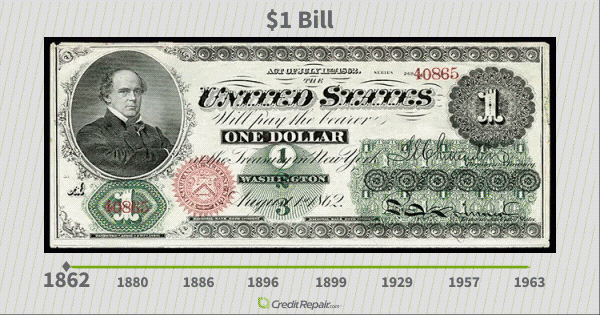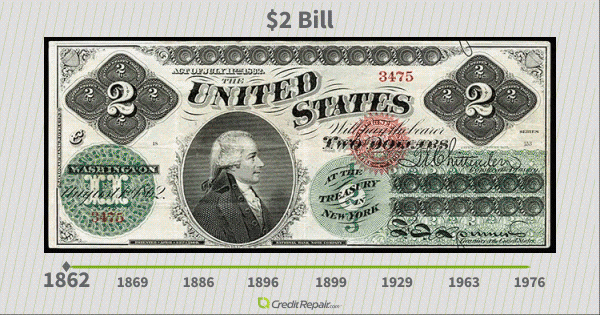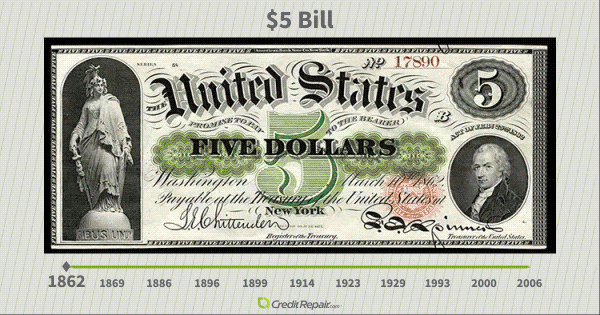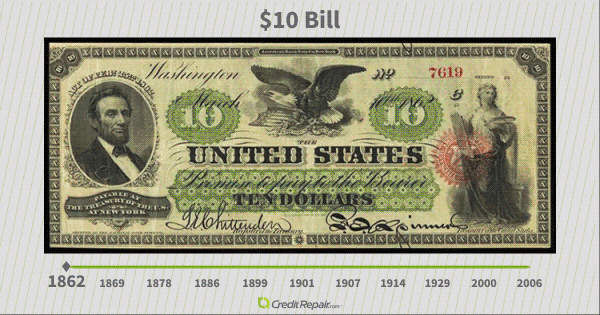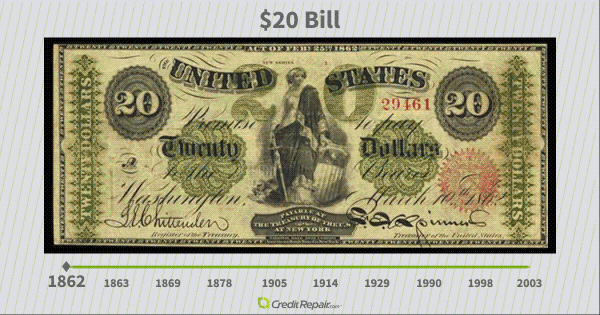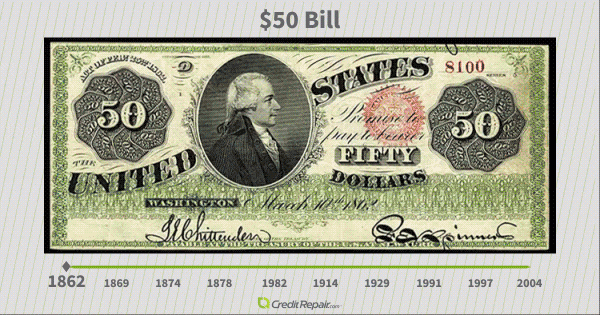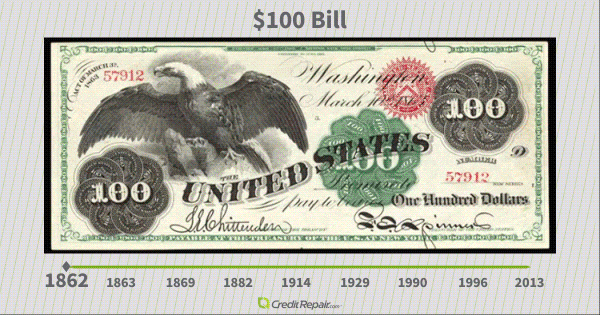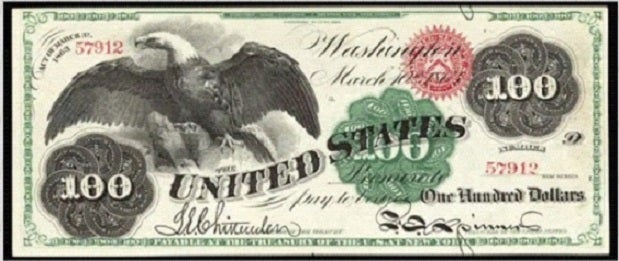 Every year our economy relies less and less on cold hard cash; plastic forms of payment and mobile commerce are completely transforming our transactions. But while those newer payment options offer desirable convenience, they lack the iconic, intricate allure of the bills they’re rapidly replacing. America’s currency has undergone several face lifts throughout our nation’s history, and with each new iteration of a given denomination, engineers at the U.S. Bureau of Engraving and Printing meticulously implement new detail. Our currency also reflects its cultural moment, revealing which historical personages from our past we find most deserving of our national esteem.
Every year our economy relies less and less on cold hard cash; plastic forms of payment and mobile commerce are completely transforming our transactions. But while those newer payment options offer desirable convenience, they lack the iconic, intricate allure of the bills they’re rapidly replacing. America’s currency has undergone several face lifts throughout our nation’s history, and with each new iteration of a given denomination, engineers at the U.S. Bureau of Engraving and Printing meticulously implement new detail. Our currency also reflects its cultural moment, revealing which historical personages from our past we find most deserving of our national esteem.
Recently, the U.S. Treasury Department made news with its announcement that a woman will appear on the $10 bill in 2020, and discussions about which person is most worthy of that honor will continue. It’s worth noting this won’t be the first instance in which women have appeared on our money: Martha Washington took that title back in 1886 on the $1 bill. It’s that kind of little-known fact that this projects attempts to capture: We gathered images of bills throughout American history and combined them in the morphing graphics below. See how our cash has changed over the centuries, and read who’s on each bill as well as other notes of historical interest about each image!
$1 Bill
- 1862 – $1 Legal Tender Note
- Salmon P. Chase, Secretary of the Treasury
- 1880 – $1 Legal Tender Note
- George Washington in the center; Christopher Columbus vignette on the left
- 1886 – $1 Silver Certificate
- Martha Washington, the First Lady
- 1896 – $1 Silver Certificate
- Educational Series depicting history instructing youth in front of Washington, D.C.
- 1899 – $1 Silver Certificate
- Bald eagle in the center; Abraham Lincoln on the left; Ulysses S. Grant on the right
- 1929 – $1 Silver Certificate (re-sized to current dimensions of 6.14 inches by 2.61 inches)
- George Washington
- 1957 – $1 Silver Certificate
- George Washington, with the addition of “In God We Trust”
- 1963 – $1 Federal Reserve Note
- George Washington
$2 Bill
- 1862 – $2 Legal Tender Note
- Alexander Hamilton
- 1869 – $2 United States Note
- Thomas Jefferson; Washington, D.C., vignette on the right
- 1886 – $2 Silver Certificate
- Winfield Scott Hancock, Civil War general
- 1896 – $2 Silver Certificate
- Educational Series depicting science revealing steam and electricity to commerce and manufacturing
- 1899 – $2 Silver Certificate
- George Washington, surrounded by figures of agriculture and mechanics
- 1929 – $2 United States Note (re-sized to current dimensions of 6.14 inches by 2.61 inches)
- Thomas Jefferson
- 1963 – $2 United States Note
- Thomas Jefferson, with the addition of “In God We Trust”
- 1976 – $2 Federal Reserve Note
- Thomas Jefferson
- William Windom, in 1891, was another notable figure on a version of the $1 bill.
$5 Bill
- 1862 – $5 United States Note
- Alexander Hamilton on the right; a statue representing freedom on the left
- 1869 – $5 United States Note
- Andrew Jackson on the left; pioneer family vignette in the center
- 1886 – $5 Silver Certificate
- Ulysses S. Grant
- 1896 – $5 Silver Certificate
- Educational Series depicting electricity given to classical figures
- 1899 – $5 Silver Certificate
- Running Antelope, head chief of the Hunkpapa and advisor to Sitting Bull
- 1914 – $5 Federal Reserve Note
- Abraham Lincoln
- 1923 – $5 Silver Certificate
- Abraham Lincoln
- 1929 – $5 Federal Reserve Note (re-sized to current dimensions of 6.14 inches by 2.61 inches)
- Abraham Lincoln
- 1993 – $5 Federal Reserve Note
- Abraham Lincoln; anti-counterfeiting measures included microscopic printing and a plastic security strip
- 2000 – $5 Federal Reserve Note
- Abraham Lincoln; further anti-counterfeiting measures but without color-shifting ink
- 2006 – $5 Federal Reserve Note
- Abraham Lincoln; further anti-counterfeiting measures included color-shifting ink
- Other notable figures on a version of the $5 bill included Christopher Columbus and an Indian princess in 1870.
$10 Bill
- 1862 – $10 United States Note
- Abraham Lincoln on the left; a figure representing art on the right; a bald eagle in the center
- 1869 – $10 United States Note
- Daniel Webster, senator and Secretary of State, on the left; Pocahontas at the Royal Court of England on the right
- 1878 – $10 Silver Certificate
- Robert Morris, senator and Revolutionary War financier
- 1886 – $10 Silver Certificate
- Thomas A. Hendricks, senator and vice president to Grover Cleveland
- 1901 – $10 United States Note
- Meriwether Lewis on the left; William Clark on the right; an American bison in the center
- 1907 – $10 Gold Certificate
- Michael Hillegas, first treasurer of the United States
- 1914 – $10 Federal Reserve Note
- Andrew Jackson
- 1929 – $10 Federal Reserve Note (re-sized to current dimensions of 6.14 inches by 2.61 inches)
- Alexander Hamilton
- 1990 – $10 Federal Reserve Note
- Alexander Hamilton; anti-counterfeiting measures included microscopic printing and a plastic security strip
- 2000 – $10 Federal Reserve Note
- Alexander Hamilton; further anti-counterfeiting measures included color-shifting ink and an ultraviolet-sensitive thread that glows orange
- 2006 – $10 Federal Reserve Note
- Alexander Hamilton; further anti-counterfeiting measures and addition of the Statue of Liberty’s torch and “We the People” from the Constitution
- Other notable figures on versions of the $10 bill included Salmon P. Chase in 1863 and Benjamin Franklin in 1870.
$20 Bill
- 1862 – $20 United States Note
- A figure of Lady Liberty
- 1863 – $20 Gold Certificate
- Bald eagle vignette
- 1869 – $20 United States Note
- Alexander Hamilton on the left; a figure of Victory on the right
- 1878 – $20 Silver Certificate
- Stephen Decatur, U.S. Navy commodore
- 1905 – $20 Gold Certificate
- George Washington
- 1914 – $20 Federal Reserve Note
- Grover Cleveland
- 1929 – $20 Federal Reserve Note (re-sized to current dimensions of 6.14 inches by 2.61 inches)
- Andrew Jackson
- 1990 – $20 Federal Reserve Note
- Andrew Jackson; anti-counterfeiting measures included microscopic printing and a plastic security strip
- 1998 – $20 Federal Reserve Note
- Andrew Jackson; further anti-counterfeiting measures included color-shifting ink and a watermark
- 2003 – $20 Federal Reserve Note
- Andrew Jackson; further anti-counterfeiting measures and addition of a bald eagle
- Other notable figures on versions of the $20 bill included James Garfield in 1882, John Marshall in 1890, and Hugh McCulloch in 1902.
$50 Bill
- 1862 – $50 United States Note
- Alexander Hamilton
- 1869 – $50 United States Note
- Henry Clay, senator and Secretary of State, on the right; a figure holding a laurel branch – symbol of victory – on the left
- 1874 – $50 United States Note
- Benjamin Franklin on the left; a figure of Lady Liberty on the right
- 1878 – $50 Silver Certificate
- Edward Everett, senator and Secretary of State
- 1882 – $50 Gold Certificate
- Silas Wright, senator
- 1914 – $50 Federal Reserve Note
- Ulysses S. Grant
- 1929 – $50 Federal Reserve Note (re-sized to current dimensions of 6.14 x 2.61)
- Ulysses S. Grant
- 1991 – $50 Federal Reserve Note
- Ulysses S. Grant, anti-counterfeiting measures included microscopic printing and a plastic security strip
- 1997 – $50 Federal Reserve Note
- Ulysses S. Grant, further anti-counterfeiting measures included color-shifting ink, an ultraviolet-sensitive thread, and a watermark
- 2004 – $50 Federal Reserve Note
- Ulysses S. Grant, further anti-counterfeiting measures and addition of an American Flag
- Other notable figures on versions of the $50 bill included George Washington in 1870 and William H. Seward in 1891.
$100 Bill
- 1862 – $100 United States Note
- Bald eagle vignette
- 1863 – $100 Gold Certificate
- Bald eagle vignette
- 1869 – $100 United States Note
- Abraham Lincoln on the left; a scene representing architecture on the right
- 1882 – $100 Gold Certificate
- Thomas H. Benton, senator
- 1914 – $100 Federal Reserve Note
- Benjamin Franklin
- 1929 – $100 Federal Reserve Note (re-sized to current dimensions of 6.14 inches by 2.61 inches)
- Benjamin Franklin
- 1990 – $100 Federal Reserve Note
- Benjamin Franklin, anti-counterfeiting measures included microscopic printing and a plastic security strip
- 1996 – $100 Federal Reserve Note
- Benjamin Franklin, further anti-counterfeiting measures included color-shifting ink, an ultraviolet-sensitive thread that glows red, and a watermark
- 2013 – $100 Federal Reserve Note
- Benjamin Franklin, further anti-counterfeiting measures included a 3D security ribbon and addition of a quill and quotes from the Declaration of Independence
- Other notable figures on versions of the $100 bill included George Washington in 1863 (interest-bearing note), James Monroe in 1878, and David G. Farragut in 1890.
Methodology
Our money used to hold value in silver or gold coin before being permanently switched to fiat currency in 1971. We included these early versions in our morphs and switched to the current Federal Reserve Notes when applicable. We only featured the notes that made a significant change for each denomination since there was such a plethora of designs early on.
Sources
http://www.newmoney.gov/currency/history.htm
http://www.oldcurrencyvalues.com/Oversized_US_Currency.html
http://www.panix.com/~clay/currency/
Fair Use
Feel free to use any of the images found on this page; however, we request that you link to this page and attribute CreditRepair.com so that your readers may have access to all the information that is available here.




